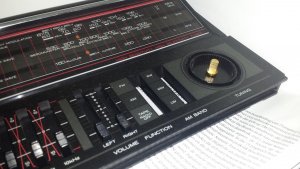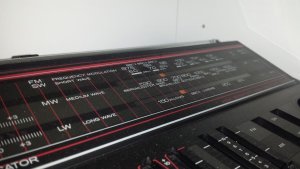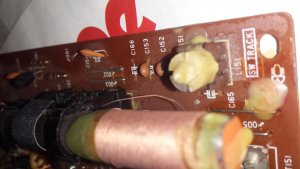Ouch, i should have seen those resistors in parallel earlier ! Your clear schematics really helped !
I'm using a small wurth digital multimeter, the advertised precision is 1.2% for potential measurement.
I forgot to mention I cleaned all sliders and switches thoroughly with contact cleaner when I received it, and moved the rec and tuner/tape switches ~50 times (as said by you in another thread).
I don't know why I forgot to measure the transistors, but here are all related to the tape audio part:
Q401L: E = 0v B = 0.698v C = 1.9v
Q401R: E = 0v B = 0.704v C = 2.28v
Q801L: E = 1.123v B = 0.496v C = 4.27v
Q801R: E = 1.175v B = 0.55v C = 3.65v
Q502: E = 6.76v B = 0.653v C = 9.04v
Q402: E = 13.71v B = 13.4v C = 13.80v ???
Q801L: E = 13.25v B = 12.34v C = 13.9v " " "
I didn't mention the output of the AC/DC circuit is pretty high: between 14 and 15.5v (it might not be made for france's 250v supply...) according to the service manual, it can be rewired for 250v. But in another thread I read you saying that the voltage from acdc's is often higher while not under load.
I'll have to remember the formula you used in your 2nd post, it's very useful !
Wow ! Those 'quick rules' are good to know !! could be a sticky if you ask me. Tomorrow I'll recheck the whole circuit, but with those rules applied, especially the last one.
I don't know if I'm making your day, but what I know is that you"re making mine
I'm using a small wurth digital multimeter, the advertised precision is 1.2% for potential measurement.
I forgot to mention I cleaned all sliders and switches thoroughly with contact cleaner when I received it, and moved the rec and tuner/tape switches ~50 times (as said by you in another thread).
I don't know why I forgot to measure the transistors, but here are all related to the tape audio part:
Q401L: E = 0v B = 0.698v C = 1.9v
Q401R: E = 0v B = 0.704v C = 2.28v
Q801L: E = 1.123v B = 0.496v C = 4.27v
Q801R: E = 1.175v B = 0.55v C = 3.65v
Q502: E = 6.76v B = 0.653v C = 9.04v
Q402: E = 13.71v B = 13.4v C = 13.80v ???
Q801L: E = 13.25v B = 12.34v C = 13.9v " " "
I didn't mention the output of the AC/DC circuit is pretty high: between 14 and 15.5v (it might not be made for france's 250v supply...) according to the service manual, it can be rewired for 250v. But in another thread I read you saying that the voltage from acdc's is often higher while not under load.
I'll have to remember the formula you used in your 2nd post, it's very useful !
Wow ! Those 'quick rules' are good to know !! could be a sticky if you ask me. Tomorrow I'll recheck the whole circuit, but with those rules applied, especially the last one.
I don't know if I'm making your day, but what I know is that you"re making mine





